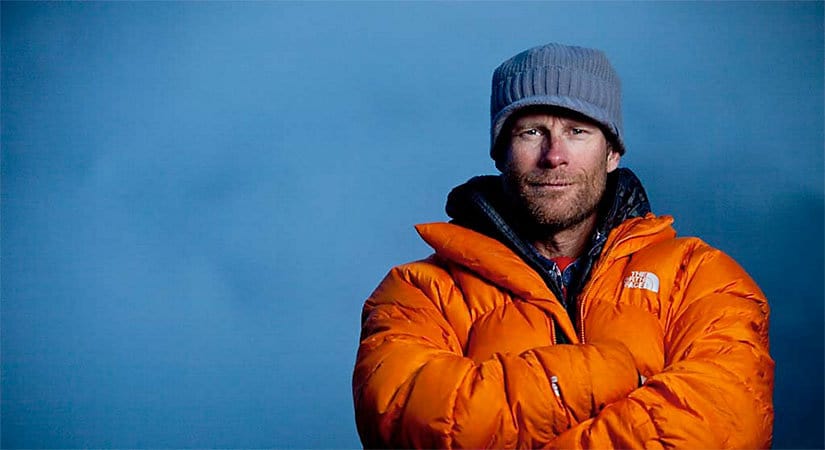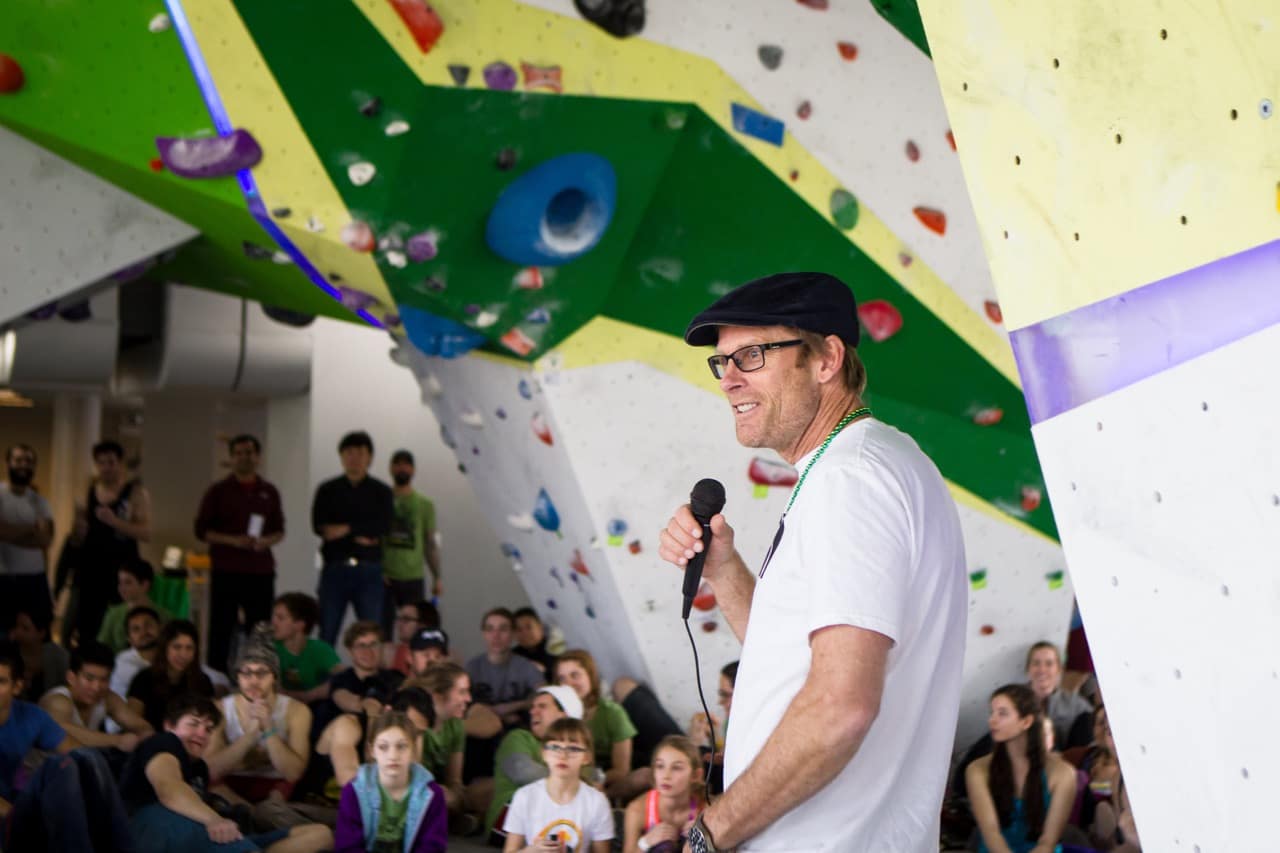A few weeks ago I spoke with the Captain of the North Face Athlete Team and star of the recent Sundance award-winning documentary Meru. Conrad Anker was kind enough to sit down for this interview as part of the Uptown Throwdown comp on March 12, 2016.

Still making cutting edge first ascents at 53 years old, Conrad, somehow, almost unbelievably so, continues to keep pace with the current generation of gym bred climbers like David Lama and Alex Honnold. But like most of his generation of outdoorsmen, his climbing began as an extension of his previous outdoor pursuits. (The following interview has been lightly edited for clarity and concision. Conrad’s words )
Conrad: Thirty, forty years ago the way you were introduced to climbing was the backcountry experience. It was a logical progression. So there was backpacking and then there were backcountry skills, and from one level to the next you eventually get to a spot where you get to go climbing. I was on a backpacking trip with my family and we had been out for 10 days. On the last day, I was like, “Oh, I don’t want this to end, this is too much fun.” It was in the Sierras so it was probably going from highway 120 to highway 108. Between those two highways in the Central Sierra, that was the family haunt so to say.
They’d pack up the mules and go. Seriously. This background and prominence give Conrad a unique perspective on the development of the sport. He’s witnessed the ethics and motivations transform as climbers have stopped coming up through the wilderness and started through rock climbing gyms. His own views have also transformed.
Back in the sixties and seventies purists believed every climbing route should be established from the ground up. The climber would only place bolts as high as he or she could climb. But as sport climbing developed, there were those who found this bolting style limited and began bolting routes on rappel.
Conrad: Back when I was climbing with Mugs I was really ground up. Now I’m like, “at the end of the day, the rap bolting versus ground up, it matters only to the firstascensionist.” Everyone else is going to climb on the route. The responsibility of the first ascensionist is to make the finest crafted route possible. When you’re in the mountains, you go ground up, because you have to. But for cragging, you have finite resources.

For a route that’s done from the ground up: it’s a statement about the person and the ego. If you go to the Needles in California, and look at the routes they put up in the 80s and early 90s, it’s all about ego and one-upmanship between these climbers. And it’s cool if you’re a 5.11, 5.12 climber and you’re climbing a 5.10X route but there’s also 5.8 and 5.9 routes that have one bolt.
As climbing has become more popular, mentalities have changed. This change is partly owed to the advent of the climbing gym. Gym climbing has shifted what once was a sport about finding solitude to one that is more and more interested in finding solidarity.
Conrad: There’s a lot less of the anger and the territorialism and provincialism now, because of the gyms. Everybody’s just there to work out. The vibe at the bouldering gyms specifically is very supportive and like, “you can do this!”

I was out climbing with a buddy this weekend and we were talking about what it was like climbing here 15 or 20 years ago with the discussion of who did a new route and how was the route put in. The animosity between different factions of people came to a head in Yosemite with fistfights and putting axle grease on routes, and chopping bolts. Climbing gyms have done a good job to make us better and healthier and communicate better as a community.
At this point now we’ve realized that there’s really not that much that you want to get worked up about. How you look at those routes is very different from where we are now. Climbing gyms do help out though. There are more polite people at the climbing gym…usually.
Not only has the ethic changed, but climbers have gotten stronger by training day-in-day-out in the gym. When you climb indoors you can focus more specifically on your weakness and you don’t have to take a rest day because of passing thunderstorms.
Conrad: Climbing has progressed because there are climbing gyms, there’s no question about that. People are climbing at a higher level because they can train climbing specific muscles, and they can start at a young age. You look at the climbing programs now, the afternoon programs. There are kids that in first grade thatare climbing in a climbing gym. When I got started you had to go through this whole apprenticeship and mentorship, you had to find someone. And then it was the round 1-inch webbing and oval carabiners. You had to go outside. You had to live near the cliffs, and know someone who knew the cliffs. Mathew Segal, grew up in Florida, raised in a climbing gym. That was his first exposure.
The proliferation of gyms isn’t just a boon for the climbing community. It’s good for our country too.
Conrad: We have an epidemic of type 2 diabetes in this country. And get it together America go to the climbing gym. I’m psyched that people are getting into climbing from the climbing gym. A healthier America is more important than overcrowded crags. So that’s my theory.
But Conrad is not all roses about climbing gyms. There a sense of entitlement that gym climbing breeds. Many of us have heard our gym-buff partner complaining about outdoor grades being sandbagged. Even still, gym climbingcan breed a complacency with the risks inherent in climbing.
Conrad: Gym climbers expect bolts every three feet or whatever the industry norm is. So you go to some crags and they’re completely over-bolted. And there’s no sport in it. For someone that grows up in the gym who hasn’t ever been out in July: “Wo, it’s four o’clock in the mountains and there are dark clouds coming in. What do I do?” You don’t get that experiential knowledge in the climbing gym.
Still, climbing gyms can facilitate the transition from gym to crag. One of the most important functions of a climbing gym is to train climbers to be responsible: both with their impact on other climbers and when it comes to potentially dangerous situations.
Conrad: A lot of a gym’s function is public education: learn how to belay well, learn to wear helmets. The other part of it is it will help get them outdoors. A lot of it is onbehalf of the American Alpine Club and the Access Fund and climbing groups that say, “these are the best practices. As you progress from being in the climbing gym, to being outdoors, this is how you’re going to change and move.”

Ultimately, for Conrad, the gym is about training to be outdoors. He talked at length about climbing at The Shop when he lived Salt Lake City. But gym climbing has its shortcomings in preparing to climb outside.
Conrad: Yeah, you can run laps at the gym, but that will only get you so far if you want to climb the Nose in a day. If you want to do that, you’ve gotta step up and get a lot of mileage on granite.
Mileage: Conrad Anker certainly has that. If you watch Meru or read any accounts of his exploits you know that he has it. But even though he has it, he’s still humble and willing to be humbled. At the Uptown Throwdown a few weeks ago, he climbed the boulder problems, which are admittedly not his forte. He climbed, and he got and he gave encouragement, and if he wasn’t who he is, you could have mistaken him for anyone else at the comp.
